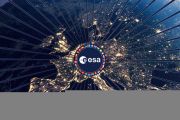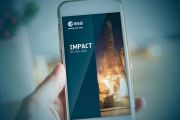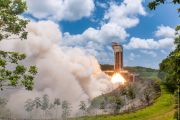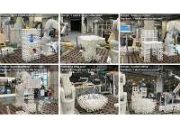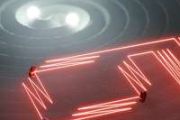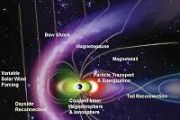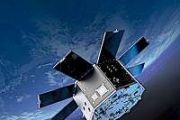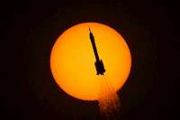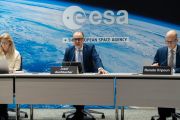
Copernical Team
Claro Brasil to Extend 4G and 5G-Ready Mobile Services Across Amazon Region with SES's O3b mPOWER
 With unprecedented demand for high-powered mobile connectivity in the most isolated communities of the Amazon, SES has signed a multiyear capacity renewal with Claro Brasil, through Embratel, its corporate solutions division, to enable the delivery of enhanced 4G/5G-ready services via its O3b mPOWER network, SES's next-gen medium earth orbit (MEO) communications system, in at least eight of 23 c
With unprecedented demand for high-powered mobile connectivity in the most isolated communities of the Amazon, SES has signed a multiyear capacity renewal with Claro Brasil, through Embratel, its corporate solutions division, to enable the delivery of enhanced 4G/5G-ready services via its O3b mPOWER network, SES's next-gen medium earth orbit (MEO) communications system, in at least eight of 23 c NASA inflatable heat shield finds strength in flexibility
 How does something that looks like a stack of orange inner tubes covered in a black tarp survive temperatures reaching 3,000 degrees Fahrenheit as it plunges through the atmosphere? An upcoming technology demonstration uses advanced materials to make a heat shield that's tougher than it looks.
Hypersonic Inflatable Aerodynamic Decelerator (HIAD) technology has been in development for more
How does something that looks like a stack of orange inner tubes covered in a black tarp survive temperatures reaching 3,000 degrees Fahrenheit as it plunges through the atmosphere? An upcoming technology demonstration uses advanced materials to make a heat shield that's tougher than it looks.
Hypersonic Inflatable Aerodynamic Decelerator (HIAD) technology has been in development for more UCF researcher receives NASA award to develop revolutionary rocket engine technology
 A University of Central Florida researcher has received NASA funding to further develop a novel rocket engine system that could revolutionize space travel.
The project focuses on rotating detonation rocket engines (RDREs), which are powered by continuous Mach 5 explosions that rotate around the inside of the engine and are sustained by hydrogen and oxygen propellants fed into the system in
A University of Central Florida researcher has received NASA funding to further develop a novel rocket engine system that could revolutionize space travel.
The project focuses on rotating detonation rocket engines (RDREs), which are powered by continuous Mach 5 explosions that rotate around the inside of the engine and are sustained by hydrogen and oxygen propellants fed into the system in D-Orbit signs launch contract with AAC SpaceQuest
 Space logistics and transportation company D-Orbit announced the signing of a launch contract with AAC SpaceQuest, the US subsidiary of AAC Clyde Space. SpaceQuest is a well-established satellite manufacturer and operator specialized in small satellite technologies and space data services.
The agreement covers the launch and deployment of an initial two satellites, based on SpaceQuest's ne
Space logistics and transportation company D-Orbit announced the signing of a launch contract with AAC SpaceQuest, the US subsidiary of AAC Clyde Space. SpaceQuest is a well-established satellite manufacturer and operator specialized in small satellite technologies and space data services.
The agreement covers the launch and deployment of an initial two satellites, based on SpaceQuest's ne ESA astronauts help map Europe’s light pollution from space

Discovery funding transforms ESA patents into commercial success

Whether sending European spacecraft to distant frontiers, studying our home planet in greater detail than ever before, or designing new launch systems, ESA activities drive the development of new technologies.
The Incredible Adventures of the Hera mission – Tales of Terrific Technology
 Video:
00:02:56
Video:
00:02:56
Meet Hera, our very own asteroid detective. Together with two CubeSats – Milani the rock decoder and Juventas the radar visionary – Hera is off on an adventure to explore Didymos, a double asteroid system that is typical of the thousands that pose an impact risk to planet Earth.
Suitable for kids and adults alike, this episode of ‘The Incredible Adventures of Hera’ details the miniaturised James-Bond-style technology that Hera and its CubeSats will carry aboard with them to explore their asteroid target.
TanSat's first attempt to detect human-caused CO2 is successful
 An international research team has analyzed measurements from the TanSat mission and the Copernicus Sentinel-5 Precursor mission to identify carbon dioxide from human activities. This is the first attempt to use TanSat measurements to detect anthropogenic, or human-caused, carbon dioxide emission signatures. Quantifying anthropogenic carbon dioxide emissions is one of the most important requirem
An international research team has analyzed measurements from the TanSat mission and the Copernicus Sentinel-5 Precursor mission to identify carbon dioxide from human activities. This is the first attempt to use TanSat measurements to detect anthropogenic, or human-caused, carbon dioxide emission signatures. Quantifying anthropogenic carbon dioxide emissions is one of the most important requirem NASA announces Unidentified Aerial Phenomena study team members
 NASA has selected 16 individuals to participate in its independent study team on unidentified aerial phenomena (UAP). Observations of events in the sky that cannot be identified as aircraft or as known natural phenomena are categorized as UAPs.
The independent study will begin on Monday, Oct. 24. Over the course of nine months, the independent study team will lay the groundwork for future
NASA has selected 16 individuals to participate in its independent study team on unidentified aerial phenomena (UAP). Observations of events in the sky that cannot be identified as aircraft or as known natural phenomena are categorized as UAPs.
The independent study will begin on Monday, Oct. 24. Over the course of nine months, the independent study team will lay the groundwork for future China to invest in major space programs
 China Aerospace Science and Technology Corp, the country's leading space contractor, will continue to invest in major space programs such as the manned lunar missions and the development of a super-heavy carrier rocket, said the company's chairman.
Chairman Wu Yansheng told reporters on Saturday that his company has set three goals for its future development - upgrading the existing rocket
China Aerospace Science and Technology Corp, the country's leading space contractor, will continue to invest in major space programs such as the manned lunar missions and the development of a super-heavy carrier rocket, said the company's chairman.
Chairman Wu Yansheng told reporters on Saturday that his company has set three goals for its future development - upgrading the existing rocket 









